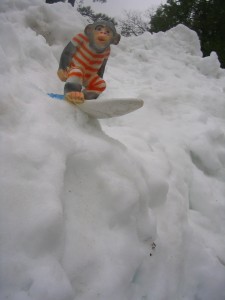Okay, maybe “history” is not the best term, “legend” might be more appropriate.
There are a few things we know about this 8 toed, plaster-of-paris, irregularly painted monkey on a Surf Board.
First of all, the Surf Monkey is not a monkey at all. It’s a chimpanzee. And if you are not a primatologist, perhaps you are unaware that chimpanzees are in the Ape family. For more, see Monkey Facts.
The Surf Monkey was birthed in the Tijuana border region 40 plus years ago and has resided almost entirely at the border crossing vendor booths awaiting adoption by gringos heading back home to the States. According to Steve, last name withheld, a regular at the Tourmaline Pacific Beach parking lot, “the monkey was at the border in ’69.” So the first Surf Monkey sighting we know about was 43 years ago.
The female Surf Monkey was first seen in 2009. We believe this is due to the shyness of their nature.
The Surf Monkey is affectionately known as “Chango,” (male) or “Changa” (female), which is slang for monkey in Mexican Spanish. They have a relatively small natural habitat, stretching from the Tijuana/Rosarito/Tecate/Ensenada area. There has been stories of births occurring in States farther South in mainland Mexico, but it is our understanding that the monkeys no longer propagate outside of the border region. What is amazing about these little guys, is that even though they are a relatively fragile species, their dispersion throughout the country has been well documented and impressive. They are known to reside in at least 25 states and will probably turn up in all 50, when more research is collected. The Surf Monkey’s Facebook page is a good source of stories and pictures of Surf Monkeys throughout the country.
Southern California is their most preferred region. Thousands have made their home on lawns, shelves, and in the garages of these beautiful coastal communities, giving them the name “Southern California Lawn Gnome.” It is somewhat surprising to discover that these plaster primates seem to also thrive in many of our land-locked states. And colder climates have not deterred them, in fact, in snowy regions these highly adaptable creatures have been seen using their 15-inch boards as snowboards!
For years, these much-loved creatures have been prolific. In the past three years, however, researchers, such as the highly acclaimed Surf Monkey research team from Surf Monkey Fellowship, have been finding their numbers dwindling to the point of great concern. Surf Monkey Fellowship and partners, will not stand by and allow this beloved species to go the way of the Dodo Bird. We are committed to Saving the Tijuana Surf Monkey from extinction! If you would like to help this noble effort, the best way is to wear a Surf Monkey on your t-shirt or adopt your own Surf Monkey.
You can find more info on our “About” page and “Home” page.
If you have any info on the Surf Monkey, please email us at SurfMonkeyFellowship@gmail.com




